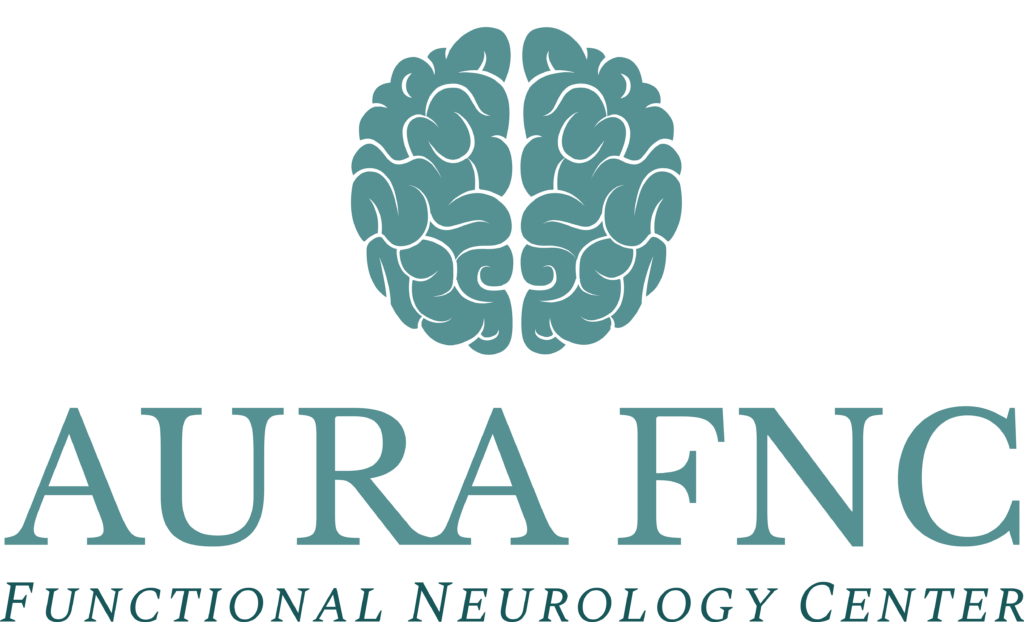What is a Migraine?
Understanding migraine disorder and how migraine applies to you as a unique individual can help find the right treatment plan. Dr. Diana Tyler our head Functional Neurologist from Aura Functional Neurology Center (Aura FNC) educates on the symptoms, treatments, causes, and triggers that surround migraine to offer a better understanding of this condition.
As a migraine patient herself, Dr. Diana Tyler provides first-hand experiences with how she has been able to treat and manage her own migraine headaches over the years of learning and practicing functional nutrition, and functional neurology using concepts from applied clinical neuroscience.

Dr. Diana Tyler DC, DACNB
Founder of Aura Functional Neurology Center. Board Certified Chiropractic Neurologist and migraine specialist with extensive experience treating migraine cases at the Aura FNC office located in Cumming, Georgia, right outside of Atlanta. Graduate of Palmer College of Chiropractic and Diplomate of the American Chiropractic Neurology Board.
Migraine is a neurological condition that affects over 1 billion people worldwide every year and is very common in females and young adults, with some serious implications according to the National Library of Medicine. Migraine headaches include reoccurring episodes of intense, throbbing headaches, often accompanied by other neurological symptoms such as nausea, vomiting, and sensitivity to light and sound. The symptoms of migraine can vary from person to person and are often felt on one side of the head.
Many people also experience certain onset symptoms before a migraine occurs. Identifying these symptoms ahead of time can help prevent or manage a migraine before it becomes severe. The duration of a migraine attack can vary from a few hours up to several days.
While some medications can provide relief or help manage migraine, many people still suffer from symptoms daily. In these cases, Dr. Diana Tyler has found that her 5-day, 10-day, or 15-day Migraine Rehabilitation Programs can provide additional relief. These programs focus on rehabilitating the brain from a functional perspective by performing brain exercises based on concepts from applied clinical neuroscience.

Migraine Symptoms
While there are several different types of migraine symptoms and onset symptoms, there are four primary “types” or “stages” of migraine that someone might experience. These different stages aren’t experienced by everyone who suffers from migraine, however, males, females, children, teenagers, and adults have the potential to experience all four stages. These stages in typical order of occurrence are prodrome, aura, attack, and post-drome, all of which Dr. Diana Tyler offers treatment plans for at Aura FNC.
Prodrome
Migraine prodrome refers to the phase that precedes the onset of a migraine attack, often characterized by a range of warning signs and symptoms. Recognizing these prodromal symptoms is critical to managing and mitigating the impact of migraine attacks and includes:
- Mood Changes:
Shifts in mood, including irritability, anxiety, or euphoria. - Fatigue:
Feeling unusually tired or lethargic. - Cognitive Changes:
Difficulty concentrating, confusion, or experiencing a “foggy” feeling. - Sensory Sensitivity:
Heightened sensitivity to light, sound, or smells. - Muscle Stiffness:
Tension or stiffness in the neck and shoulders. - Food Cravings:
Craving specific foods or experiencing changes in appetite. - Yawning:
Excessive yawning may occur in some individuals. - Increased Thirst:
A heightened sense of thirst before the headache phase.
Aura
Migraine aura is a distinct phase that some individuals experience before or during a migraine attack, marked by transient and reversible neurological symptoms. Approximately 1/3 of migraine patients will experience these accompanying symptoms. These symptoms typically precede the headache phase and serve as an additional indicator of an impending migraine. Not everyone experiences aura symptoms, but those that do might experience:
- Visual Distortions:
Distinct visual disturbances, such as seeing shimmering lights, or experiencing partial vision loss. - Speech and Language Disturbances:
Difficulty speaking coherently, finding the right words, or language disruptions. - Motor Weakness or Paralysis:
Temporary loss of strength or paralysis in specific parts of the body, often on one side. - Tingling or Numbness:
Sensations of tingling, numbness, or a “pins and needles” feeling, in the face or extremities. - Olfactory Hallucinations:
Unusual or heightened sense of smell, sometimes accompanied by phantom odors. - Auditory Disturbances:
Hearing disruptions, such as ringing in the ears or changes in volume perception. - Vertigo or Dizziness:
A sensation of spinning or dizziness, which may be accompanied by loss of balance. - Cognitive Impairments:
Difficulty with thinking processes, memory lapses, or experiencing a sense of unreality. - Time Perception Alterations:
Distorted perception of time, with minutes feeling like hours or vice versa.
Attack
During a migraine attack, individuals often experience a combination of symptoms that can be intense and debilitating. These symptoms, distinct from prodrome and aura, signify the peak phase of the migraine episode. The intensity of these symptoms can vary from person to person and might include:
- Pulsating Headache:
Throbbing or pulsating pain, often on one side of the head, reaching moderate to severe intensity. - Nausea and Vomiting:
Intense feelings of nausea, sometimes leading to vomiting. - Photophobia:
Increased sensitivity to light, making it uncomfortable or painful to be in well-lit environments. - Phonophobia:
Heightened sensitivity to sound, making loud noises unbearable. - Osmodysphoria:
Discomfort or aversion to certain smells. - Aura Continuation:
Persistence or exacerbation of aura symptoms, though these can vary in intensity. - Visual or Auditory Hallucinations:
Intensified visual disturbances, ringing in the ears, or other sensory anomalies.
Post-Drome
Following the acute phase of a migraine attack, individuals may enter the post-drome or “migraine hangover” stage. This phase is characterized by a gradual resolution of symptoms but can still have lingering effects such as:
- Fatigue:
Lingering feelings of exhaustion and lethargy. - Mood Changes:
Continued mood fluctuations, such as irritability or a sense of elation. - Cognitive Fog:
Difficulty concentrating, memory lapses, or a general feeling of mental fogginess. - Body Aches and Pains:
Muscular discomfort or generalized body aches. - Residual Sensitivity:
Mild sensitivity to light, sound, or smells may persist. - Emotional Sensitivity:
Heightened emotional responses or increased vulnerability. - Appetite Changes:
Altered appetite, with some individuals experiencing increased hunger or a lack of interest in food.
Migraine Rehabilitation Programs
Dr. Diana Tyler offers migraine treatment in the form of a 5-day, 10-day, or 15-day brain rehabilitation program at the Aura Functional Neurology Center office in Cumming, Georgia. These rehabilitation programs are customized to patients based on their symptoms and unique needs. Many of our patients who come for migraine treatment at Aura FNC will travel from other cities in Georgia, fly in from other states around the U.S.A., and some will even travel internationally for our migraine rehabilitation programs.
Dr. Diana Tyler treats migraine from a functional and neurological perspective using neuroplasticity and brain training to positively influence the complex interactions between genetics, environmental factors, and changes in brain chemistry that surround migraine. She focuses on strengthening the area of the brain dysfunction that is contributing to your migraine headaches while also addressing the contributing structural and metabolic factors.
Migraine treatment at Aura FNC involves a combination of lifestyle and dietary modifications, nutritional support, neurological rehabilitation, and treatment of the spine. Our approach is based on Chiropractic Functional Neurology and the latest research in clinical neuroscience.
Aura FNC, a private practice with limited capacity, accepts a restricted number of patients annually for our migraine rehabilitation programs. This allows for personalized 1:1 sessions with Dr. Diana Tyler, offering 15, 30, or 45 hours of individual treatment across 1, 2, or 3 weeks in a private office setting.
Migraine Causes
We know that migraine is a complex neurological condition that occurs as a result of genetic predisposition. The migraine brain is indeed unique, marked by distinctive structural and functional changes that set it apart from non-migraine brains.
Both acute migraine attacks and the chronic nature of migraine contribute to these alterations, impacting various areas of the brain. Understanding these changes is essential in developing effective interventions, and this is where brain rehabilitation and functional neurology play a crucial role.
Structural Brain Changes
- Cortical Thickness:
Studies have shown alterations in cortical thickness in migraine sufferers, particularly in areas associated with pain processing and sensory perception. These changes can influence how the brain interprets and responds to stimuli, contributing to the manifestation of migraine. - Hippocampal Volume:
The hippocampus, a region crucial for memory and emotional regulation, may exhibit changes in volume. This can be linked to the emotional and cognitive aspects often associated with migraine. - Subcortical Structures:
Brain regions like the thalamus and basal ganglia, which play a role in sensory processing and motor control, may change, impacting the overall function of the nervous system.
Functional Brain Changes
- Altered Connectivity:
Migraine brains often display altered connectivity patterns between different brain regions. These changes may contribute to the hypersensitivity and increased susceptibility to triggers characteristic of migraine. - Hyperexcitability:
There is evidence of increased neuronal excitability, particularly in the brainstem and cortical areas, leading to a decreased threshold for migraine initiation. - Neurotransmitter Imbalance:
Imbalances in neurotransmitters such as serotonin and dopamine are common in migraineurs, influencing mood, pain perception, and overall brain function.
Unlike typical treatments, this approach gets to the root of your migraine disorder. At Aura FNC, our goal is not only to alleviate your symptoms but also to enhance your brain’s resilience and capabilities. We achieve this by comprehending the workings of the migraine brain and providing the necessary support it requires.
The unique characteristics of the migraine brain call for a tailored approach. Functional neurology focuses on improving brain function, providing a hopeful path for those looking for more than just relief from migraine but long-term improvement in overall brain function.
Migraine Triggers
Triggers vary among individuals, but common factors include certain foods (such as chocolate, caffeine, and aged cheeses), hormonal fluctuations in women, changes in sleep patterns, stress, and sensory stimuli like bright lights or loud noises—depending on the regions of the brainstem and cortex involved in your migraine case.
Additionally, external environmental factors like weather changes and strong odors can act as triggers and lower the threshold for some individuals. Understanding these diverse factors help in the development of personalized strategies for managing and preventing migraine:
Hormonal Changes
- Menstrual cycle fluctuations.
- Pregnancy-related hormonal shifts.
- Menopause.
- Medical conditions like polycystic ovary syndrome (PCOS), endometriosis, and estrogen sensitivity.
Foods and Beverages
- Chocolate.
- Caffeine (either excess or withdrawal).
- Aged cheeses.
- Artificial sweeteners.
- Processed foods containing monosodium glutamate (MSG).
- Alcohol, particularly red wine, and beer due to histamine and yeast.
Caffeine
- Sudden intake or withdrawal of caffeine.
- Excessive use (over 2 cups or 200mg per day)
Environmental Factors
- Bright or flickering lights.
- Loud noises.
- Strong odors or perfumes.
- Changes in weather or atmospheric pressure.
Sleep Disturbances
- Lack of sleep.
- Irregular sleep patterns.
- Excessive sleep.
- Sleep disorders (sleep apnea, insomnia)
Stress and Emotional Factors
- Emotional stress.
- Anxiety.
- Depression.
- Physical or mental exhaustion.
Physical Triggers
- Intense physical exertion.
- Posture-related strain.
- Skipped meals or irregular eating patterns.
Medication Overuse
- Excessive use of pain relievers, including over-the-counter medications.
- Excessive use of triptans
Hormonal Medications
- Hormonal contraceptives.
- Hormone replacement therapy (HRT).
Dehydration
- Inadequate fluid intake.
- Not enough minerals.
- Lack of electrolytes.
- Low sodium.
Types of Migraine We Treat
Complex Migraine
A complex migraine is characterized by the presence of an aura that can manifest as visual disturbances, sensory changes, or language difficulties. Unlike typical migraine, complex migraine involves neurological symptoms that may mimic transient ischemic attacks (TIAs) or strokes. These episodes can be unsettling due to the temporary but profound alterations in perception and function.
Ocular Migraine
Ocular migraine is unique in that it primarily affects vision. These migraine attacks cause temporary visual disturbances or blindness in both eyes, often accompanied by shimmering or flashing lights. The visual symptoms can be frightening, but they usually resolve within an hour. It's important to differentiate ocular migraine from other eye conditions, as they are related to migraine activity in the brain rather than issues with the eyes themselves.
Vestibular Migraine
Vestibular migraine primarily affects the vestibular system, leading to symptoms such as dizziness, vertigo, and imbalance. Individuals with vestibular migraine may experience these symptoms with or without a headache. The disruption to balance and spatial orientation can be disconcerting, making everyday activities challenging during an episode.
Chronic Migraine
Chronic migraine is characterized by the frequent occurrence of migraine attacks, typically defined as headaches occurring on 15 or more days per month for at least three months. These individuals often experience a mix of migraine and tension-type headache symptoms, significantly impacting daily life. Effective management strategies are crucial to improve the quality of life for those dealing with chronic migraine.
Retinal Migraine
Retinal migraine, unlike ocular migraine which affects both eyes, is when someone experiences symptoms or loss of vision in one eye only. Retinal migraine specifically involves blood vessel spasms in the retina. The visual symptoms are usually reversible and short-lived, with full vision returning after the episode resolves.
Hemiplegic Migraine
Hemiplegic migraine is a rare and severe form of migraine with aura. They involve temporary paralysis or weakness on one side of the body, along with other aura symptoms such as vision changes, difficulty speaking, and confusion. These migraine attacks can be alarming due to the neurological symptoms, and individuals experiencing them may require medical attention to rule out more serious conditions.
Menstrual Migraine
Menstrual migraine is specifically linked to hormonal fluctuations during the menstrual cycle. Typically occurring in the days leading up to, during, or after menstruation, these migraine attacks are often more severe and challenging to manage than non-menstrual migraine. Holistic hormonal regulation and lifestyle adjustments are commonly used to address menstrual migraine patterns.
Silent Migraine
Silent migraine, also known as acephalgic migraine, manifests without the typical headache pain associated with migraine. Instead, individuals may experience aura symptoms such as visual disturbances, sensory changes, or language difficulties. While the absence of headache pain might seem less disruptive, the neurological symptoms can still significantly impact daily activities.
